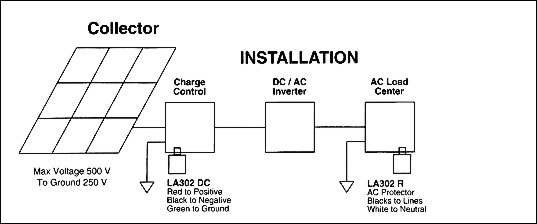|
HOW ARRESTORS AFFECT
SURGES Surges are comprised of two elements: voltage and quantity of charge. A very high voltage surge can damage equipment by breaking down the insulating medium between elements in a
circuit or between those elements and a ground. The amount of damage will be determined by the current from the charge and/or current from the power source. In order to protect a circuit from damage, a surge arrestor
must conduct sufficient charge from the surge to lower the surge voltage to a safe level quickly enough to prevent circuit insulation from breaking down. All circuits can withstand a high voltage for a
short time. The shorter the time becomes, the higher the tolerable voltage becomes. Consider a fifty thousand volt surge impressed on a two-hundred-forty volt apparatus having a surge arrestor connected parallel. The
surge arrestor will begin to conduct the charge, bleeding it out of the circuit. As the charge is removed from the circuit, the surge voltage will fall. As the charge approaches zero the surge voltage will approach
zero. If this happens quickly enough the apparatus will be protected. How quickly an arrestor can eliminate a surge from a circuit depends on four factors: the magnitude of the voltage, the quantity of
the charge, the speed at which the arrestor starts conducting, and the conductivity of the arrestor. Given two arrestors, one having double the conductivity of the other, one will handle the surge twice as rapidly as
the other. Given two arrestors of the same conductivity but one which begins to conduct more quickly, the quicker one will eliminate the surge from a circuit more quickly. |
|
CLAMPING VOLTAGE vs. DISCHARGE VOLTAGE There is no one clamping voltage for any arrestor. The clamping voltage will vary according to the amount of current being conducted, the internal resistance of the arrestor,
the response speed of the arrestor, and the point in time at which the clamping voltage is measured. When a clamping voltage is specified, the current being clamped should be stated. For example, 500 volts at 1000 amps.
Anytime there is a clamping voltage specified with no current there is no real meaning. If one uses a negligible current, such as one milliamp, any clamping voltage can be achieved. However, there is no protection
afforded. Consider a surge which rises from zero to fifty thousand volts in five nanoseconds, connected to an arrestor which starts to conduct at five nanoseconds, and clamps the surge to 500 volts in
100 nanoseconds. At any point in time during the one-hundred five nanoseconds, the clamping (discharge) voltage would be different. Even though the clamping voltage can be said to be 500 volts, if measured at
twenty-five nanoseconds the clamping voltage would be above twenty-five thousand volts. An arrestor with a low ultimate clamping voltage might have a low conductivity which would cause the high voltage to exist in the
circuit for a longer period of time. Arrestors with a high conductivity (low internal resistance) can conduct surges from the circuit more rapidly. Arrestors having a high current rating will have a high conductivity
and will conduct a surge from the circuit more rapidly. The quicker a surge is eliminated, the more likely the equipment will be protected. Any reference to clamping voltage should always include the amount of current
being clamped, and the clamping time. |
|

